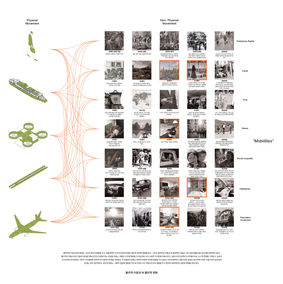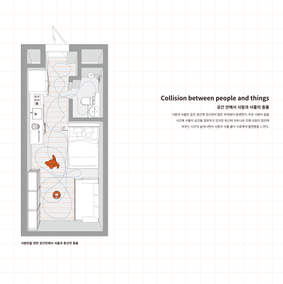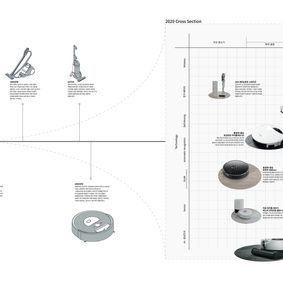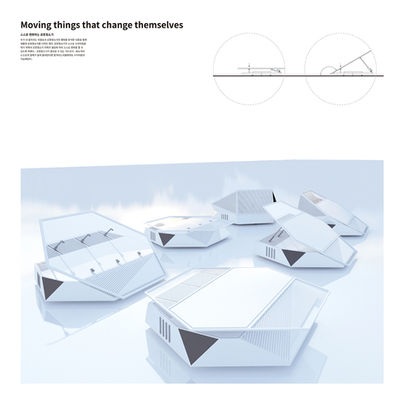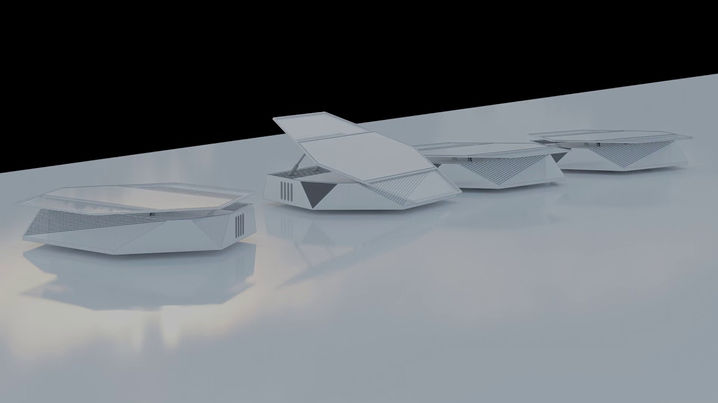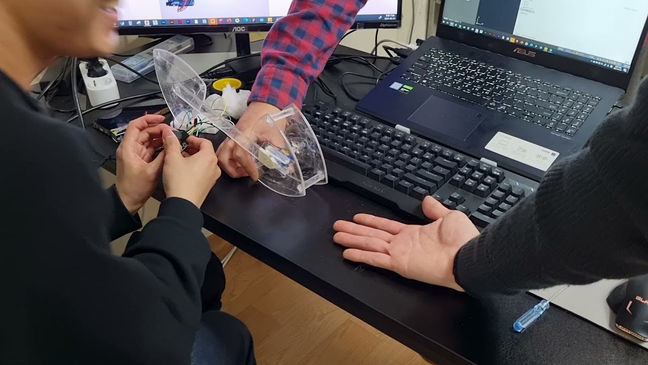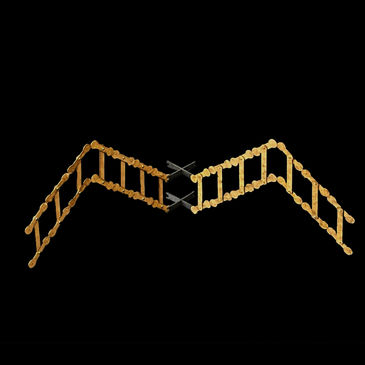움직이는 사물과 사람의 공존
Breathing Architecture
양인혁, Inhyeok Yang
@yangin.93
2020-2022

Mobility
모빌리티 관점에서 변화하는 사회
‘모빌리티’는 물리적인 이동뿐만 아니라 사회적 변화같은 비 물리적인 이동도 포함한다. 모빌리티 관점에서 역사적으로 사회는 사물(물리적 이동수단, 기술이 담긴 물건 등)의 발달과 함께 변화했으며, 변화된 사회는 사람들 삶의 형식을 바꾸게 하였다.
Mobility includes not only physical movements but also non-physical movements such as social changes. From the perspective of mobility, historically, society has changed with the development of things (physical transportation, things containing technology, etc.), and the changed society has changed the way people live.
이동수단의 발달과 데이터 기기의 발전
The development of transportation and data devices.
물리적인 이동수단과 데이터 모두 이동의 측면에서 속도가 중요하다. 물리적인 이동수단은 비 물리적인 상황과 인식에 영향을 준다. 이동수단은 ‘1시간에 얼마큼 이동할 수 있느냐’가 중요하기 때문에 사람들이 더 빨리, 더 멀리 이동하도록 발전되어왔다. 데이터 기계들은 반도체 패러다임의 변화에 따라 발전해왔다. 데이터 역시 속도가 중요하기 때문에 더 빠른 속도를 내기 위해 발전중이며, 속도와 더불어서 ‘더 많은 정보를 어떻게 생산, 전달하여 얼마큼 많은 저장 공간에 저장 할 수 있는가’도 중요한 지점이다.
Speed is important in terms of movement for both physical means of transportation and data. Physical means of transportation affect non-physical situations and perceptions. Transportation has been developed to help people travel faster and farther because it is important how much they can travel per hour. Data machines have developed according to changes in the semiconductor paradigm. Data is also developing to speed up faster because speed is important, and in addition to speed, "how much more information can be produced and delivered and stored in storage space" is also an important point.






인구이동과 가구구조의 변화
Changes in population movement and household structure


물리적인 이동수단과 데이터 기기는 인구를 이동시켰으며, 지역 공동체에서 벗어나 네트워크를 통한 새로운 사회를 이루게 하였다. 인구이동과 새로운 사회는 대가족이 함께 살던 가구구조에서 1인가구로의 삶의 형식역시 변화시켰다.
Physical means of transportation and data devices have moved the population and have led to a new society through the network away from the local community. Population movement and a new society have also changed the form of life from the household structure where large families lived together to single-person households.
사물과 주거
Things and housing
주거 내 사물은 사람이 하던 일을 대신 해주��는 ‘가전’ 과 공간을 이루는 ‘가구’ 로 분류할 수 있다. 20세기 이전에는 공간을 이루는 사물, ‘가구’가 주거공간을 이루었으나 20세기 이후에 사람을 대신하는 사물 가전이 나오게 되었다. 가전의 발달은 초기 가사노동의 해방을 위해 진행 되었으며 현재는 사회적 가구구조의 변화와 스스로 움직이는 기술에 발 맞춰 발전중이다.
Things in the house can be classified into "home appliances" that replace what people do and "furniture" that makes up space. Before the 20th century, 'furniture', an object that makes up space, formed a residential space, but after the 20th century, household appliances on behalf of people came out. The development of home appliances was carried out to liberate domestic labor in the early days, and is now developing in line with changes in the social furniture structure and self-moving technologies.




사물과 공간과의 관계, 모델하우스
Relationship between objects and space, Model house.
모델하우스는 그 시대보다 한 발짝 더 나아간 미래의 주거모습을 보여준다. 모델하우스의 변화과정을 보면 주거 내 사물들은 공간과 끊임없이 관계를 맺으며 발달해온 것을 볼 수 있다. 좌식생활에서 침대의 보급화로 입식생활이 익숙해지고 TV와 소파의 위치에 따라 아파트 평면 정해지고 바닥에 놓이던 에어컨이 벽에 걸렸다가 천장에 매입되는 과정을 겪고 있다.
The model house shows the future housing that has taken a step further than that era. Looking at the change process of the model house, it can be seen that objects in the house have been constantly related to space and developed. Due to the spread of beds in sedentary life, standing-up life has become familiar, and the air conditioner, which was set on the floor, is being hung on the wall and purchased on the ceiling according to the location of TV and sofas.




사물의 위상변화
Changes in the status of things.
물리적인 이동수단과 데이터 기기, 주거 내 사물 등의 발전에는 위상이 변화하는 시점들이 있다. 거리가 발달됨에 따라 걷는 것이 편해졌고 증기의 발달은 기차와 자동차를 만들었으며 전기의 발견은 수많은 가전제품을 만들게 하였다. 현재 우리가 맞닿고 있는 위상의 변화시점은 전기 저장장치의 발달과 1인가구의 증가, ai/iot의 발전, virus 시대이다.
There are times when the phase changes in the development of physical transportation, data devices, and things in the house. As the streets developed, walking became easier, and the development of steam made trains and cars, and the discovery of electricity led to the creation of numerous home appliances. The time point of change in our current status is the development of electrical storage, the increase of single-person households, the development of ai/iot, and the virus era.



미래 주거 예측
Future housing forecast.
미래의 주거를 예측해보자면 공간을 이루면서 동시에 사람을 대신하는 사물이 나오면서 가전과 가구의 경계가 없어질 것이다. 또한 사물과 공간은 더욱더 서로 관계를 맺으며 발전할 것이다. 사물 자체가 건축요소로서 사용될 수도 있고, 로봇 팔이 상용화 된다면 주방의 모습 역시 달라질 것이다. 비대면의 활성화로 디스플레이를 활용한 방이나, 물류배송을 고려한 현관 역시 지금의 모습과는 다를 것이다.
To predict future housing, the boundaries between home appliances and households will disappear as things that form space and replace people at the same time emerge. In addition, things and spaces will develop more and more in relation to each other. Things themselves can be used as architectural elements, and if robot arms are commercialized, the appearance of the kitchen will also change. Rooms using displays due to non-face-to-face activation, or entrances considering logistics delivery, will also be different from the current appearance.




현관
Portal
‘현관'은 건물의 출입문이나 건물에 붙어 따로 달아낸 어귀 라는 말이다. 현대에 와서 사람들에게 현관은 자신의 주거를 들어가기 전 전이공간으로 생각할수 있다. 2020년 코로나사태로 인해 현관의 모습은 변화하고 있다. 우리가 알던 물리적인 현관을 넘어 심리적, 주관적으로 현관의 모습은 개개인 마다 다를 수 있다.
Portal is the entrance to a building or a separate entrance attached to the building. In modern times, people can think of the front porch as a transition space before entering their residence. The appearance of portal is changing due to the 2020 COVID-19 crisis. Beyond the physical porch we knew, the appearance of the portal can be different for each individual psychologically and subjectively.


주거에서의 Portal
Portal in residential area.
현재 주택에서의 현관 개념을 다시 바라볼 수 있다. 단독주택에서의 마당과 포치, 다가구 주택에서 계단과 대문, 다세대 주택에서의 계단, 엘리베이터, 복도 등을 현관으로 볼 수 있다. 공동주택단지로 보면 개념이 더 확장되는데, 개개인의 성향에 따라 주차장, 자전거보관소, 커뮤니티시설, 울타리, 게이트 까지를 현관으로 볼수도 있다.
We can look back at the concept of a front door in our current house. We can see the yard and porch in detached houses, stairs and gates in multi-family houses, stairs in multi-family houses, elevators, and corridors as the front door. In terms of apartment complexes, the concept is further expanded, and depending on individual preferences, parking lots, bicycle storage facilities, community facilities, fences, and gates can be viewed as entrances.
사물의 관점에서 Portal
From an object's point of view, Portal.
이동수단, 주거 내 사물에게 현관은 크기와 이동성, 위생 등 때문에 경계가 제약된 측면이 있었다. 집안 현관까지 들어올 수 있는 자전거와 전동킥보드, 주차장이 현관인 자동차가 있는 반면 집안에서 벗어날 수 없는 로봇청소기도 있다. 앞으로 사물이 스스로 움직이게 된다면 경계가 달라질 것이다. 공용공간과 연계되어 사물들을 위한 공용공간이 필요할 것이며 사물들이 다니는 통로, 사물끼리 모이는 공간이 필요할 수도 있다.
For transportation means and things in the house, Portal had a limited boundary due to size, mobility, and hygiene. There are bicycles that can enter the front door of the house, electric kickboards, and cars with parking lots as the front door, while there are robot vacuum cleaners that cannot escape the house. In the future, if things move on their own, the boundaries will change. In connection with the public space, a public space for things will be needed, and a passage through which things travel and a space where things gather may be needed.
로봇청소기
Robot Vacuum
2020년을 기준으로 로봇청소기는 점점 더 스마트한 방향으로 발전하고 있다. ai/iot가 결합되어 음성인식으로 청소가 가능한 제품, 자동으로 먼지통을 비우는 제품, 창문을 닦는 제품 등 다양한 기능들을 가지고 발전중이다. 가장 흥미로운 것은 로봇청소기에서 벗어나 이젠 공기청정기 까지 스스로 움직이는 것이 나왔다. 앞으로는 청소기, 공기청정기 이외에 더 많은 스스로 움직이는 사물들이 나올 것으로 예상된다.
As of 2020, robot vacuum cleaners are developing in a smarter direction. It is developing with various functions such as a product that can be cleaned by voice recognition by combining ai/iot, a product that automatically empties dust cans, and a product that cleans windows. The most interesting thing was to move away from the robot vacuum cleaner and now the air purifier by itself. In the future, more self-moving objects are expected to emerge besides vacuum cleaners and air purifiers.


로봇청소기의 센서와 휠
Sensors and wheels of robot vacuum cleaners.
로봇청소기의 주요 부품에는 ‘눈’의 역할을 하는 센서와 ‘다리’의 역할을 하는 휠이 있다. 센서는 기능에 따라 가격이 천차만별인데, 초음파를 보내서 장애물과의 거리를 측정하는 초음파 센서, 거리와 각을 재서 움직이는 자이로 센서, lidar센서를 이용해서 거리를 측정하는 lds 센서, 카메라를 이용한 카메라 센서가 대표적이다. 휠의 경우 대부분 메일 휠 2개 서브휠 1개가 기본이며, 메인 휠은 각각이 제어 모터를 사용하여 제자리 회전이 가능하다.
The main components of the robot cleaner include a sensor that acts as an 'eye' and a wheel that acts as a 'leg'. Sensors vary in price depending on their functions, and ultrasonic sensors that measure the distance to obstacles by sending ultrasonic waves, gyro sensors that measure distance and angle, lds sensors that measure distance using lidar sensors, and camera sensors using cameras are typical. In most cases, two mail wheels and one subwheel are basic, and each of the main wheels can rotate in place using a control motor.















Moving Things
지금까지 사람의 행태만 고려해왔다면, 사람과 움직이는 사물의 공존을 위해 사물의 행태도 고려할 필요가 있다. 스스로 움직이는 사물로서 가장 대표적인 로봇청소기를 분석하여 새로운 Moving Things를 디자인 하였다. 로봇청소기는 주행시 회전반경이 자신의 폭의 반으로서 왔던 길을 한 번씩 더 되돌아가는 습성이 있으며, 로봇청소기의 한계인 층간이동을 위해서는 각 34도 이하의 경사여아 한다.
If only human behavior has been considered so far, it is necessary to consider the behavior of objects for the coexistence of people and moving objects. A new Moving Things was designed by analyzing the most representative robot vacuum cleaner as a self-moving object. Robot vacuum cleaners have the habit of turning the turning radius back once more as a half of their width when driving, and each slope of 34 degrees or less should be made to move between floors, which is the limit of robot vacuum cleaners.



Moving Things는 이것들을 반영하여 스스로 주행과 형태를 각 30도까지 변형시킬 수 있게 디자인 하였다. 주거공간에서 가장 보편적으로 사용되는 가구는 소파, 테이블, 책상, 침대, 의자 등이 있다. 따라서 Moving Things의 형태변형과 조합을 통해 보편적인 가구를 구성하였다.
Moving Things reflected these and designed them to transform their driving and shape to 30 degrees each. The most commonly used furniture in residential spaces includes sofas, tables, desks, beds, and chairs. Therefore, universal furniture was constructed through the morphological transformation and combination of Moving Things.
Moving Things와 예상 가능한 시나리오
Moving Things and predictable scenarios



Moving Things를 이용하여 새로운 주거 모습을 예상해 본다면, 사람이 없을 때 현관 밖의 택배를 스스로 수거해 오거나, 사람이 집안으로 들어올 때 현관 앞에서 정화시스템을 가동 시킬 수도 있으며, 스스로 형태 변형과 조합을 통해 가구가 되어 소파, 책상, 침대 의자 등을 구성할 수도 있다.
If you predict a new residential appearance using Moving Things, you can collect parcels outside the front door when there are no people, operate a purification system in front of the front door when people enter the house, or furniture through shape modifications and combinations to form sofas, desks, and bed chairs.
Wheeling System
Moving Things는 시스템이 아닌 하나의 객체이기 때문에 조합의 방식에 한계가 있다. 따라서 Wheeling System을 새롭게 디자인 하였다. Wheeling System은 로봇청소기 행태분석을 반영하여 스스로 주행도 가능하고 프레임과 힌지로 형태 변형을 통한 폭과 높이를 변형 시킬 수 있다. Wheel의 개수를 늘림으로서 형태 변형 상태에서도 주행이 가능하게 하였다.
Since Moving Things is not a system but an object, there is a limit to the way of combination. Therefore, the Healing System was redesigned. The Healing System can drive on its own by reflecting the robot cleaner behavior analysis and can transform the width and height through shape deformation with frames and hinges. By increasing the number of wheels, it was possible to drive even in a deformed state.




건축적 요소
Architectural Elements
시스템의 높이변화, 형태 변화를 이용하여 건축적 요소를 구성한다. 각 시스템이 조합되기 위한 기어조인트, 볼 조인트 등을 디자인 하였다. H형태, 사다리꼴 형태, 일자형태 등 다양한 형태는 조합을 통해 구조적 역할과 설비를 위한 공간을 구성이 가능하다. 건축의 기본 요소인 바닥, 벽, 기둥, 천장을 구성하고 수직이동을 위한 계단, 경사 등을 구성할 수 있다. 시스템의 구동원리인 전기는 조합된 시스템이 직립이 가능하고 형태를 유지할 수 있게 한다.
Construct architectural elements using changes in height and shape of the system. Gear joints and ball joints for combining each system were designed. Various types, such as H-shape, trapezoidal, and straight-line shape, can constitute structural roles and spaces for facilities through combinations. It is possible to construct floors, walls, pillars, and ceilings, which are basic elements of architecture, and to construct stairs and slopes for vertical movement. Electricity, which is the driving principle of the system, allows the combined system to be upright and maintain its shape.
1인 가구
Single-person households.
주거 내 가구를 구성하는 Moving Things와 건축적 요소를 구성하는 Wheeling System의 가능성을 보기 위해 1인 가구에 적용을 하였다. 1인가구의 증가는 인구이동과 데이터의 발전으로 인한 사회적 변화 이다. 2020년 38.5%으로 매해 꾸준히 증가하고 있으며, 모든 산업들이 1인 가구에 맞춰 변화하고 있다.
It was applied to single-person households to see the possibility of Moving Things that make up households in the house and the Healing System that makes up architectural elements. The increase in single-person households is a social change due to population movement and data development. It is steadily increasing every year to 38.5% in 2020, and all industries are changing according to single-person households.




1인가구의 알파 룸
α- room for a single person
1인가구의 키워드들을 보게 되면 가장 그들이 원하는 것은 ‘나만의 공간, 알파룸’ 이다. 개개인의 취미생활을 위한 공간이 기본적인 주거 공간 외에도 필요한 것이다. 알파룸은 필요에 따라 앉거나 자는 쉬는 공간부터 요리, 노래, 그림그리기 등 취미 공간까지 다양하다. 알파 룸의 성격에 따라 분류를 해보면 가장 기본적인 요소를 공간, 책상, 의자, 디스플레이로 보고 기본적인 주거행위에는 숙면, 앉아서 쉬기, tv시청 등이 있다.
When looking at keywords of single-person households, what they want the most is "my own space, alpha room." In addition to the basic residential space, space for individual hobbies is necessary. Alpha rooms range from resting areas where you sit or sleep as needed to hobby spaces such as cooking, singing, and drawing. When classified according to the nature of the alpha room, the most basic elements are viewed as space, desks, chairs, and displays, and basic residential activities include deep sleep, sitting down and resting, and watching TV.




Universal 공간만 있으면 할 수 있는 취미생활, 공간에 기본적인 가구가 필요한 취미, 디스플레이가 필요한 취미 등이 조금 더 나아간 취미행위이다. 더 나아가 피아노 연주나 기구이용 홈 트레이닝 같이 전문적인 장비나 이동이 힘든 가구, 특정 공간이 필요한 전문적 취미가 있다. 누군가에겐 주거행위까지가 알파 룸 이라면 누군가에겐 ��보편적 공간 취미, 더 나아가 전문적인 취미 까지가 알파 룸일 수 있다.
Hobbies that can be done with universal space, hobbies that require basic furniture in the space, and hobbies that require displays are more advanced. Furthermore, there are specialized hobbies that require specialized equipment, furniture that is difficult to move, and specific spaces, such as piano performance or home training for equipment use. For some, if residential activities are alpha rooms, for others, universal space hobbies, and even professional hobbies can be alpha rooms.




Breathing Space
1인 가구 알파 룸 관계도와 시스템을 가지고 제안을 시뮬레이션 돌리기 위한 시나리오를 작성하였다. 가운데 Breathing Space를 알파 룸으로 공유하는 두 사람의 시나리오다. 각자의 스케쥴에 따라 기본공간에서 알파룸으로 확장 되었다가 축소되면서 기존의 변하지 않던 면적 내에서 행해지던 행위를 시간에 따라 변화하면서 사용 하는 모습을 볼 수 있다.
A scenario was created to simulate proposals with a single-person household alpha room relationship map and system. It is a scenario of two people sharing Breath Space in the middle as an alpha room. As it expands from the basic space to the alpha room according to each schedule and then decreases, you can see that the existing actions performed within the unchanged area change over time and use them.
시스템 매뉴얼
System Manual
실내공간의 변화와 마찬가지로 외부 환경에 대응하는 건축물이 되기 위해 시스템들을 변형하였다. 시스템A 는 기본 형태로서 내부 공간의 모듈로서 개별 힌지는 서보모터를 이용하여 움직인다. 시스템B는 기둥과 천장, 바닥판의 구조로서 역할을 하는데 길이가 더 길고 이것으로 이루어진 바닥판과 기둥은 그 사이로 설비 가 지나가거나 엘리베이터가 된다. 시스템C는 바닥과 천장을 연결하는 벽기둥 역할을 하며 외부 마감의 지지대 역할을 한다.
Like the change in indoor space, the systems were modified to become buildings corresponding to the external environment. System A is a basic form, as a module in the inner space, and individual hinges move using a servo motor. System B serves as a structure of pillars, ceilings, and floorboards, which are longer and the floorboards and pillars made of them pass through them or become elevators. System C acts as a pillar connecting the floor and ceiling and serves as a support for external finishes.






스스로 주행&조립
Driving&Assembly
기존의 철골 , 콘크리트와 다른 점은 무엇인가? 개별 유닛이 스스로 주행함으로서 건축의 요소로서 역할을 하지 않을 때는 움직이는 사물로서 역할을 한다. 또한 스스로 조합이 가능이 가능하기 때문에 건물을 지을수 없는 환경에서도 적용할 수 있다.
What is the difference from existing steel frames and concrete? When individual units do not play a role as an element of architecture by driving themselves, they act as moving objects. It can also be applied to environments where buildings cannot be built because combinations are possible on their own.
환경적용
Environmental application
①남극
남극은 바람과 적설량을 고려해서 지붕을 경사로 기울이고 건물은 바닥에서 띄어야 한다. 남극이라는 환경에서 영양분 섭취를 위한 온실을 만들었으며, 펭귄을 연구하는 연구소도 설정했다. 실시간으로 필요에 따라 공간을 넓게 쓰거나 좁게 사용 가능하다.
①Antarctica
In Antarctica, the roof should be tilted in consideration of wind and snowfall, and the building should float on the floor. It has created a greenhouse for nutrient intake in an environment called Antarctica, and has also set up a research institute to study penguins. In real time, space can be widely used or narrowly used as needed.
②해양
네덜란드 플로팅건축을 반영하여 바다위에서 가축이나 채소를 키우는 공간을 설정하였다. Breathing Space 하나가 요트처럼 독립적으로 바다 위를 떠다니면서 낚시하는 공간이 될 수도 있다. 해양이라는 특성에 맞게 1층에서는 낮에 수영이 가능한 공간이 되었다가 저녁에는 다 같이 모여 영화를 보는 공용공간이 된다.
②Ocean
Reflecting the Dutch floating architecture, a space for growing livestock or vegetables on the sea was established. One Breath Space can be a space for fishing while floating independently on the sea like a yacht. In accordance with the characteristics of the ocean, it becomes a public space where swimming is possible during the day on the first floor, and then in the evening, it becomes a public space where everyone gathers and watches movies.
③도심
남극, 해양과는 다르게 도시는 사람들과의 관계가 중요하다. 저층은 사람들을 위해 낮에는 팝업 스토어처럼 사용되다가 저녁에는 다 같이 모이는 광장역할을 할 수 있다. 윗 층은 1인가구들이 모여 사는 주거공간이 되어서 실시간으로 본인들의 필요에 따른 공간으로 사용할 수 있다.
②Downtown
Unlike Antarctica and the ocean, city relationships with people are important. The lower floor can serve as a pop-up store during the day for people and then as a plaza where everyone gathers together in the evening. The upper floor becomes a residential space where single-person households live and can be used as a space according to their needs in real time.
③숲속자연
해충과 야생동물로부터 피하기 위해 건물을 바닥에서 띄우고 자연이라는 특성에 맞게 옥상에서 캠핑하는 공간을 두었다. 천문연구소도 설정하여 밤에는 건물 위에서 별을 볼 수 있다.
②Forest
In order to avoid pests and wild animals, the building was floated on the floor and a camping space was placed on the rooftop to suit the nature of nature. Astronomical research institutes have also been set up to allow you to see stars from above the building at night.
마무리
Finish
설계방법론을 연구하는 스튜디오로서 제 프로젝트는 리서치-제안-제작- 전시로 이어지는 커리큘럼으로 진행되었습니다. 리서치에서는 John Urry의 ‘Mobility’을 읽고 이동수단과 데이터기기를 Time Matrix로 정리하고 주거공간내에서 사물의 발달, 주거에서의 현관의 의미, 앞으로 주목할만한 사물 ‘로봇청소기’를 리서치 하였습니다. 제안에서는 리서치 내용을 바탕으로 앞으로 주목할만한 ‘스스로 움직이는 사물’을 새롭게 디자인 함으로서 그것들이 만들어 낼수 있는 가구, 공간, 건축을 디자인하였습니다. 내적논리를 만들어 시스템을 만들고 실제로 제작함으로써 가능성을 더 탐구하였고, 외적논리에 맞춰 적용가능성을 보기 위해 1인가구와 다양한 환경을 설정하여 시뮬레이션 해봤습니다.
모빌리티는 물리적인 이동뿐만 아니라 비 물리적인 변화도 포함합니다. 저는 물리적인 이동수단과 데이터 기기의 발전이 비 물리적인 사회에 어떻게 영향을 끼쳤는지 부터 바라봤습니다. 사회는 사물의 발달과 함께 변화해 왔고 도시, 건축, 주거공간과도 영향을 주고 받습니다. ‘지난날의 변화 양상을 봐왔다면 앞으로 주목할만한 사물의 발달은 무엇이고 사회는 어떻게 변화할 것인가?’가 프로젝트의 시작점이 되었습니다.
![[GSUA2021]양인혁.mp4_20211205_143845_edited](https://static.wixstatic.com/media/57bf09_6a5d1c7b9a814b51b22a2bf1685da938~mv2.jpg/v1/fill/w_912,h_515,al_c,q_85,usm_0.66_1.00_0.01,enc_avif,quality_auto/%5BGSUA2021%5D%EC%96%91%EC%9D%B8%ED%98%81_mp4_20211205_143845_edited.jpg)
2년간 Top-Down과 Bottom-Up 을 번갈아 가며 진행했고 리서치와 제안을 여러 번 반복해가면서 진행했음에도 논리적, 내용적 부족한 부분이 많습니다. 하지만 기존의 설계방법과는 다르게 작은 사물에서부터 시작하여 가구, 건축, 더 나아가 도시까지 확장시키는 새로운 설계방법론을 익힐수 있었습니다.
제 프로젝트는 기존의 이동수단이 다니던 길에 이제는 스스로 움직이는 사물도 함께 다니고, 건축이 어려운 지역에 스스로 주행과 조립을 하여 건물을 짓고, 사용자의 필요에 따라 공간이 넓어졌다 좁아졌다 하면서 공간 사용에 대한 방식을 바꾸는 ‘사물의 발달로 인한 사회적 변화’를 보여줄수 있는 ‘Breathing Architecture’ 입니다.
Mobility includes not only physical movement but also non-physical changes. I looked at how the development of physical transportation and data devices affected the non-physical society. Society has changed with the development of things and is also influenced by cities, architecture, and residential spaces. "If you have seen the changes of the past, what is the development of remarkable things in the future and how will society change?" became the starting point of the project.
As a studio studying design methodology, my project was conducted as a curriculum that runs through research-proposal-production to exhibition. In research, I read John Urry's Mobility, organized transportation and data devices into Time Matrix, and researched the development of objects in residential spaces, the meaning of the front door in housing, and a remarkable object in the future. Based on the research content, the proposal designed furniture, space, and architecture that they could create by redesigning notable "self-moving objects" in the future. We further explored the possibilities by creating internal logic, creating systems, and actually making them, and simulated them by setting up single-person households and various environments to see their applicability according to external logic.
There are many logical and content deficiencies even though we have alternately conducted Top-Down and Bottom-Up for two years and repeated research and proposals several times. However, unlike the existing design methods, we were able to learn a new design methodology that starts with small objects and extends to furniture, architecture, and even cities.
My project is "Breathing Architecture," which can show "social changes caused by the development of objects" that change the way space is used, saying that things move on their own, build buildings in areas where construction is difficult, and that space has expanded and narrowed according to user needs.







